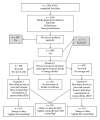Characteristics of US Health Care Providers Who Counsel Adolescents on Sports and Energy Drink Consumption
- PMID: 24790611
- PMCID: PMC3982408
- DOI: 10.1155/2014/987082
Characteristics of US Health Care Providers Who Counsel Adolescents on Sports and Energy Drink Consumption
Abstract
Objective. To examine the proportion of health care providers who counsel adolescent patients on sports and energy drink (SED) consumption and the association with provider characteristics. Methods. This is a cross-sectional analysis of a survey of providers who see patients ≤17 years old. The proportion providing regular counseling on sports drinks (SDs), energy drinks (EDs), or both was assessed. Chi-square analyses examined differences in counseling based on provider characteristics. Multivariate logistic regression calculated adjusted odds ratios (aOR) for characteristics independently associated with SED counseling. Results. Overall, 34% of health care providers regularly counseled on both SEDs, with 41% regularly counseling on SDs and 55% regularly counseling on EDs. On adjusted modeling regular SED counseling was associated with the female sex (aOR: 1.44 [95% CI: 1.07-1.93]), high fruit/vegetable intake (aOR: 2.05 [95% CI: 1.54-2.73]), family/general practitioners (aOR: 0.58 [95% CI: 0.41-0.82]) and internists (aOR: 0.37 [95% CI: 0.20-0.70]) versus pediatricians, and group versus individual practices (aOR: 0.59 [95% CI: 0.42-0.84]). Modeling for SD- and ED-specific counseling found similar associations with provider characteristics. Conclusion. The prevalence of regular SED counseling is low overall and varies. Provider education on the significance of SED counseling and consumption is important.
Figures

Similar articles
-
Pregnancy and Postpartum Related Weight Counseling Practices of U.S. Obstetrician-Gynecologists: Results from the Doc Styles Survey, 2010.J Womens Health Care. 2014;3:208. doi: 10.4172/2167-0420.1000208. J Womens Health Care. 2014. PMID: 26251763 Free PMC article.
-
Association between reported screening and counseling about energy drinks and energy drink intake among U.S. adolescents.Patient Educ Couns. 2014 Feb;94(2):250-4. doi: 10.1016/j.pec.2013.09.026. Epub 2013 Oct 14. Patient Educ Couns. 2014. PMID: 24176609
-
Association between adolescents' consumption of total and different types of sugar-sweetened beverages with oral health impacts and weight status.Aust N Z J Public Health. 2018 Feb;42(1):22-26. doi: 10.1111/1753-6405.12749. Epub 2017 Nov 22. Aust N Z J Public Health. 2018. PMID: 29165908
-
Adolescent consumption of sports and energy drinks: linkages to higher physical activity, unhealthy beverage patterns, cigarette smoking, and screen media use.J Nutr Educ Behav. 2014 May-Jun;46(3):181-187. doi: 10.1016/j.jneb.2014.02.008. J Nutr Educ Behav. 2014. PMID: 24809865 Free PMC article.
-
Energy Drink and Alcohol mixed Energy Drink use among high school adolescents: Association with risk taking behavior, social characteristics.Addict Behav. 2017 Sep;72:93-99. doi: 10.1016/j.addbeh.2017.03.016. Epub 2017 Mar 27. Addict Behav. 2017. PMID: 28388494 Review.
Cited by
-
Impact of Energy Drinks on Health and Well-being.Curr Nutr Rep. 2018 Sep;7(3):121-130. doi: 10.1007/s13668-018-0231-4. Curr Nutr Rep. 2018. PMID: 29982915 Review.
-
Development and validation of the short-form Adolescent Health Promotion Scale.BMC Public Health. 2014 Oct 26;14:1106. doi: 10.1186/1471-2458-14-1106. BMC Public Health. 2014. PMID: 25344693 Free PMC article. Clinical Trial.
-
Physician Characteristics Associated With Sugar-Sweetened Beverage Counseling Practices.Am J Health Promot. 2018 Jul;32(6):1365-1374. doi: 10.1177/0890117116680472. Epub 2016 Dec 12. Am J Health Promot. 2018. PMID: 27956472 Free PMC article.
-
Pregnancy and Postpartum Related Weight Counseling Practices of U.S. Obstetrician-Gynecologists: Results from the Doc Styles Survey, 2010.J Womens Health Care. 2014;3:208. doi: 10.4172/2167-0420.1000208. J Womens Health Care. 2014. PMID: 26251763 Free PMC article.
References
-
- Wang YC, Bleich SN, Gortmaker SL. Increasing caloric contribution from sugar-sweetened beverages and 100% fruit juices among US children and adolescents, 1988–2004. Pediatrics. 2008;121(6):e1604–e1614. - PubMed
-
- Marshall TA, Levy SM, Broffitt B, et al. Dental caries and beverage consumption in young children. Pediatrics. 2003;112(3, part 1):e184–e191. - PubMed
-
- Sugary Drink F.A.C.T.S.: Evaluating Sugary Drink Nutrition and Marketing to Youth, R.C.f.F.P. Obesity, Editor, 2011.
-
- Wescott RF. Measuring the purchases of soft drinks by students in US schools. An analysis for the American Beverage Association, 2005.
LinkOut - more resources
Full Text Sources
Other Literature Sources

